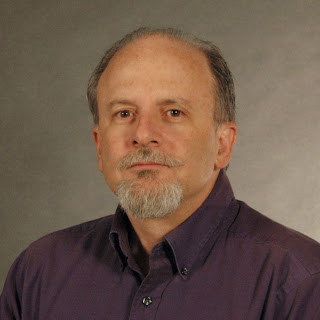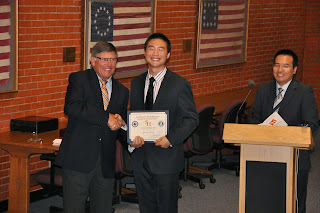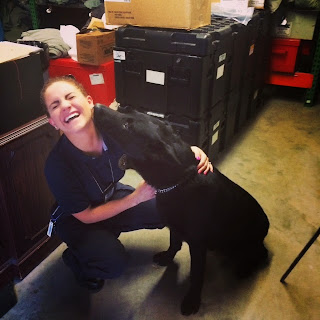
Intern Samantha Martinez looks for fingerprints on a temporary license plate.
At the Houston Forensic Science Center, Intern Samantha Martinez worked under the direct supervision and guidance from Certified Latent Print Examiner Brian O’Hare on the FBI’s Automated Fingerprint Identification System (AFIS), leading to “hits,” helping police get one step closer to solving crimes.
“I got to enhance fingerprints using Photoshop,” said Martinez, a senior and criminal justice major at Sam Houston State University. “My supervisor said a lot of the fingerprints were getting hits. We found a lot of fingerprints. I hoped they would have a match.”
One day, the Houston Forensic Science Center, which provides forensic sciences to the Houston Police Department, handled three cases, in which seven fingerprints were lifted from 14 objects taken from the scenes. Martinez observed and assisted with processing prints by applying the chemicals needed to illuminate the prints in the laser room. She watched the different processes used for porous, non-porous and semi-porous samples.

Martinez in the lab.During her three-month summer internship in the lab, Martinez got to witness the forensic investigation of a wide variety of cases, including homicides, aggravated robberies, aggravated sexual assaults, narcotics, unlawful carrying of weapons and criminal mischief. She had a “sponge-like thirst” for forensic knowledge, said her supervisor, Lt. Barry McDermott, Acting Training Director at the center.
“The internship is a mutually beneficial program to SHSU students and the Houston Forensic Science Center,” said McDermott. “The student is exposed to the duties and responsibilities of forensic practitioners in one or more forensic disciplines…The hands-on experience afforded the student will no doubt influence their future decisions with respect to solidifying a career in forensics and the discipline of choice. The Houston Forensic Science Center benefits from the assistance the interns provide in assisting our staff in accomplishing the daily functions in an effective and efficient manner.”

Martinez in the laser room.Martinez also got to see the wide array of equipment used by professionals in the field. For example, the fingerprint lab has two laser processing areas – one for small objects, like a bottle, and the other for large items, like a bicycle.
Martinez has always been fascinated with the work of a crime lab, but wanted to get hands-on experience to better identify a specialty she would like to pursue for her career. The internship at the Houston Forensic Science Center was just the ticket. She got to see in action labs that process DNA/Biology, firearms, controlled substances, toxicology, crime scene, audio-video, and digital forensic evidence.
“I got a feel for the different kinds of labs to see what they do.” said Martinez. “I really like the DNA and biology labs, and I really didn’t think I would.”
 In the biology lab, she watched analysts conduct confirmatory tests on blood, semen and oral swabs, usually in aggravated sexual assault cases. In the toxicology lab, analysts identified drug and alcohol levels in suspects by testing blood samples using gas chromatography and mass spectrometry machines.
In the biology lab, she watched analysts conduct confirmatory tests on blood, semen and oral swabs, usually in aggravated sexual assault cases. In the toxicology lab, analysts identified drug and alcohol levels in suspects by testing blood samples using gas chromatography and mass spectrometry machines.
“It was very familiar,” said Martinez, a former chemistry major. “I used many of the same tests in my classes.”
In the controlled substances lab, Martinez examined cocaine and marijuana samples under the microscope.
“It has given me a lot of knowledge about the Houston Forensic Science Center,” Martinez said. “I got my foot in the door. It gave me the understanding about how evidence comes in the doors and how it is perceived from a lab analyst point of view, not the public point of view.”
Martinez said a class she took last semester, Crime Scene Investigations, helped get her ready for the internship.
 That class reviewed every aspect of the crime lab, which she saw firsthand at the Houston Forensic Science Center.
That class reviewed every aspect of the crime lab, which she saw firsthand at the Houston Forensic Science Center.
The internship gave her more direction for her future career, which will include additional science classes and graduate level work. She plans to pursue a job at the center and continue her education.
“I went into criminal justice because I wanted to do more in the criminology field,” said Martinez. “Now I need to go back for more science.”
McDermott, too, was invested in the internship.
“We have a stake in encouraging and guiding their career aspirations, as they will someday be our colleagues and/or 'practitioners' of the future,” he said.


 Texas has laws against stalking, which makes it a second or third degree felony depending on the number of offenses. In 2011, the state passed laws allowing victims to file protective orders against perpetrators of the crime and, in 2012, Texas was one of 12 states to allow stalking charges to be processed through civil courts to compel financial compensation for victims.
Texas has laws against stalking, which makes it a second or third degree felony depending on the number of offenses. In 2011, the state passed laws allowing victims to file protective orders against perpetrators of the crime and, in 2012, Texas was one of 12 states to allow stalking charges to be processed through civil courts to compel financial compensation for victims.  More than one out of every four victims report being stalked via electronic devices or through the Internet, including cordless and cell phones, email, GPS systems, online databases, and cameras. The most common forms of cyberstalking were email, video and digital cameras, listening devices/bugs, and instant messenger.
More than one out of every four victims report being stalked via electronic devices or through the Internet, including cordless and cell phones, email, GPS systems, online databases, and cameras. The most common forms of cyberstalking were email, video and digital cameras, listening devices/bugs, and instant messenger. To address these issues, the Crime Victims’ Institute recommends that Texas needs to increase data collection and reporting on stalking and also to keep track of stalking protective orders.
To address these issues, the Crime Victims’ Institute recommends that Texas needs to increase data collection and reporting on stalking and also to keep track of stalking protective orders. 
 “This new ‘all-hazards’ approach we are taking with our programs will help students prepare to deal with any type of threat that they may encounter,” said Dr. Phillip Lyons, Interim Dean of the College of Criminal Justice.
“This new ‘all-hazards’ approach we are taking with our programs will help students prepare to deal with any type of threat that they may encounter,” said Dr. Phillip Lyons, Interim Dean of the College of Criminal Justice. By attending to the needs of both the public and private sector, the new degree seeks to graduate better informed practitioners who, among other activities, will help protect critical infrastructure that is essential to everyday lives.
By attending to the needs of both the public and private sector, the new degree seeks to graduate better informed practitioners who, among other activities, will help protect critical infrastructure that is essential to everyday lives.  In addition to the Master’s degree, the program also will offer two certificates for professionals in the field – Emergency Management and Critical Infrastructure Protection. These two certificate programs will result in quick starts for professionals and, hopefully, early successes in the field.
In addition to the Master’s degree, the program also will offer two certificates for professionals in the field – Emergency Management and Critical Infrastructure Protection. These two certificate programs will result in quick starts for professionals and, hopefully, early successes in the field. Among some of the classes that will be offered in the new program are:
Among some of the classes that will be offered in the new program are:
 “It is pretty competitive,” Dorman said. “We do hear that our agencies are getting lots of interest.”
“It is pretty competitive,” Dorman said. “We do hear that our agencies are getting lots of interest.” “Students should be open minded when seeking federal positions,” said Dr. Jim Dozier, Internship Coordinator at Sam Houston State University, College of Criminal Justice. “Getting a foot in the door of federal employment is the first of other pathways that may developed. I personally did that having been hired by The Treasury Department and later moving to the Justice Department.”
“Students should be open minded when seeking federal positions,” said Dr. Jim Dozier, Internship Coordinator at Sam Houston State University, College of Criminal Justice. “Getting a foot in the door of federal employment is the first of other pathways that may developed. I personally did that having been hired by The Treasury Department and later moving to the Justice Department.” “It comes with a lot of development opportunities,” said Dorman.
“It comes with a lot of development opportunities,” said Dorman. “When you talk about a response to this, you need to think holistically and what’s going to happen in terms of a system response,” said Dr. Wells, who collaborated with several stakeholders on the Houston project. “This is what we were able to do in Houston.”
“When you talk about a response to this, you need to think holistically and what’s going to happen in terms of a system response,” said Dr. Wells, who collaborated with several stakeholders on the Houston project. “This is what we were able to do in Houston.”  The newly created victim advocate position in the Houston Police Department provides services for victims early on in new cases and works with victims in older cases, which is intended to result in better participation in the process. Over the last year, the advocate has contacted 250 sexual assault victims, many who were unlikely to receive similar services in the past. Investigators have reported “very positive results.”
The newly created victim advocate position in the Houston Police Department provides services for victims early on in new cases and works with victims in older cases, which is intended to result in better participation in the process. Over the last year, the advocate has contacted 250 sexual assault victims, many who were unlikely to receive similar services in the past. Investigators have reported “very positive results.” 







 Nick Vaughn, Investigator for the Office of Inspector General and member of the Joint Terrorism Task Force for the Texas Department of Criminal Justice, discussed the recruitment of offenders in the state’s prisons and jails by members of terrorist or extremist organizations. Vaughn helped familiarize participants with the radicalization process and indicators they could use to identify potential members both behind bars and in the community.
Nick Vaughn, Investigator for the Office of Inspector General and member of the Joint Terrorism Task Force for the Texas Department of Criminal Justice, discussed the recruitment of offenders in the state’s prisons and jails by members of terrorist or extremist organizations. Vaughn helped familiarize participants with the radicalization process and indicators they could use to identify potential members both behind bars and in the community. The training also explored violence and the Southwest Border. Special Agent Johnnie Green of ATF looked at one of the latest tactics being employed by the Mexican cartels against rival cartels and the government: the use of Improvised Explosive Devices (IEDs). The presentations discussed the use of vehicle-borne IEDs and their firing systems and the types of weapons, explosives and munitions being seized in the Mexico and the United States.
The training also explored violence and the Southwest Border. Special Agent Johnnie Green of ATF looked at one of the latest tactics being employed by the Mexican cartels against rival cartels and the government: the use of Improvised Explosive Devices (IEDs). The presentations discussed the use of vehicle-borne IEDs and their firing systems and the types of weapons, explosives and munitions being seized in the Mexico and the United States.












 Dr. Jackson’s dissertation was “Empirical Assessment of the Theory of African American Offending among a University Sample and a Partial Test of Gender Differences in African American Offending.” Her committee included Chair Dr. Leana Bouffard and Drs. Howard Henderson and Kelly Knight. She is a Policy Analyst with the Council of State Governments Justice Center in New York.
Dr. Jackson’s dissertation was “Empirical Assessment of the Theory of African American Offending among a University Sample and a Partial Test of Gender Differences in African American Offending.” Her committee included Chair Dr. Leana Bouffard and Drs. Howard Henderson and Kelly Knight. She is a Policy Analyst with the Council of State Governments Justice Center in New York. Dr. Naito’s dissertation was “Reliability of Eyewitness Evidence: An Analysis of State-Level Decisions Using Manson v. Brathwaite’s Criteria.” Her committee was chaired by Dr. Michael S. Vaughn and included Drs. Dennis Longmire and Phillip Lyons. She is an assistant professor in the Department of Criminology at the University of West Georgia.
Dr. Naito’s dissertation was “Reliability of Eyewitness Evidence: An Analysis of State-Level Decisions Using Manson v. Brathwaite’s Criteria.” Her committee was chaired by Dr. Michael S. Vaughn and included Drs. Dennis Longmire and Phillip Lyons. She is an assistant professor in the Department of Criminology at the University of West Georgia.

 Dr. Phillip Lyons(r) speaks at the Sundial Ceremony.
Dr. Phillip Lyons(r) speaks at the Sundial Ceremony.


 Dr. Webb congratulates students from ZPC.
Dr. Webb congratulates students from ZPC.


 Alexander got to witness her first court case when she accompanied Graves to a capital murder trial in Dallas.
Alexander got to witness her first court case when she accompanied Graves to a capital murder trial in Dallas.


 Hero and Marmorato prepare to hit the street.
Hero and Marmorato prepare to hit the street.
